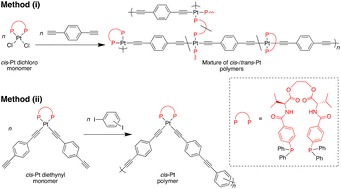Synthesis of geometry-controlled platinum-containing polymers bearing optically active bidentate phosphine ligands†
Abstract
Synthesis of platinum (Pt)-containing polymers with a controlled geometry at the Pt center has attracted attention from the viewpoints of organometallic chemistry and polymer synthetic chemistry. The present paper describes the synthesis of Pt-diyne polymers by two methods: (i) dehydrochlorination coupling polymerization of cis-PtCl2{P(Ph)2–1,4-C6H4–CONHC*H[CH(CH3)2]CO2CH2–}2 with 1,4-diethynylbenzene and (ii) Sonogashira–Hagihara coupling polymerization of cis-Pt(C![[triple bond, length as m-dash]](https://www.rsc.org/images/entities/char_e002.gif) C–1,4-C6H4–C
C–1,4-C6H4–C![[triple bond, length as m-dash]](https://www.rsc.org/images/entities/char_e002.gif) CH)2{P(Ph)2–1,4-C6H4–CONHC*H[CH(CH3)2]CO2CH2–}2 with 1,3- and 1,4-diiodobenzenes. Method (ii) was able to control the geometry of the Pt center, while method (i) could not. The polymers showed circular dichroism (CD) signals originating from the chirally fixed ligand moieties in a manner similar to the corresponding monomers, indicating that the polymers maintained the cyclic structure intact. The cyclic structure was stabilized by intramolecular hydrogen-bonding and π–π interactions, which were confirmed by single crystal X-ray analysis and density functional theory (DFT) calculations.
CH)2{P(Ph)2–1,4-C6H4–CONHC*H[CH(CH3)2]CO2CH2–}2 with 1,3- and 1,4-diiodobenzenes. Method (ii) was able to control the geometry of the Pt center, while method (i) could not. The polymers showed circular dichroism (CD) signals originating from the chirally fixed ligand moieties in a manner similar to the corresponding monomers, indicating that the polymers maintained the cyclic structure intact. The cyclic structure was stabilized by intramolecular hydrogen-bonding and π–π interactions, which were confirmed by single crystal X-ray analysis and density functional theory (DFT) calculations.



 Please wait while we load your content...
Please wait while we load your content...